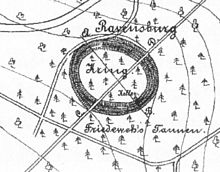Kring (Kaufunger Forest)

The Kring is a ring wall system on the Ravensberg near Hann. Münden ( Lower Saxony ). It is located in the Kaufunger Forest near the Werra and the districts of Laubach and Oberode . The rampart, which is still clearly visible in the area today, is a cultural monument , but is not signposted as such. For a long time it was interpreted as an early historical or early medieval refuge . Its origin around the birth of Christ was only recognized during the exploration of the nearby Hedemünden Roman camp around 2007, the outpost of which is the ring wall.
construction
The Kring is an oval ring wall with the dimensions of 82 × 110 meters at 395 m above sea level. NN near the Ravensberg. The inner area is around 4,000 m². The surrounding wall has been preserved over the entire length of 225 meters except for minor damage. This consisted of a height difference of about 2.5 meters from the ditch upstream to the crest of the wall. The wall has been preserved with a width of six meters and a height of around 1.5 meters. In sloping terrain, the wall is still 2.5 meters high on the outside. The trench is still up to four meters wide and about one meter deep. The archaeological investigations suggest a wood-earth construction, possibly with vertical outer walls made of wood. There are no displays for towers. The facility had a gate on the east side and at the same time at the deepest point. There is a five meter wide gap in the wall and in front of it an earth bridge in the ditch.
Naming
From the 16th century, names for the complex have been handed down to Hünenburg or modified word forms. At times the ramparts were referred to as Ravensburg because of their location on the Ravensberg . The origin of the name Kring is not known in detail, but can probably be derived from its ring wall, since Kring means a legally delimited area in Germanic . It can also be a circle in which thing meetings were held and a judgment was pronounced or enforced. Kring can also be derived from an activity, as the following Middle High German legal text shows:
- maniger wanet a master sin
- inside sineme krenge,
- the kume bleve a master,
- he walked the length with me .
Research history
A Bronze Age trade route ran past the Kring ring wall , which led from the Fuldafurt near Spiekershausen to the Werrafurt near Hedemünden . In the northern foreground of the Kring in 1881, when several barrows were opened, a hoard with 20 bronze objects from the urn field period was made. The finds were made available to museums in Hanover and the Mündener Heimatmuseum . Carl Schuchhardt carried out the first archaeological investigation of the Kring in 1892 by means of a test excavation inside the ramparts, which remained unproductive.
In 1983, on the initiative of the Hanover Institute for Monument Preservation, a topographical survey of the ramparts was carried out by students from the University of Hanover . The Göttingen District Archeology carried out prospections using metal detectors in 1988, 1991 and 2000 . The iron objects found could not initially be classified in terms of time; a later restoration identified them as Roman. After a wind thrown in 1991 with uprooted trees, charred round beechwood logs were found in a root ball hole , which suggested an earlier wood-earth construction and destruction by fire. A C14 dating of charcoal residues, which was only carried out in 2005, revealed a time in the early Roman Empire . As a result, from 2006 onwards, archaeologists again focused on the complex, as a connection with the Roman camp Hedemünden on the opposite side of the river Werra was suspected. Prospecting with metal detectors in 2006 and excavations between 2007 and 2009 with around 10 excavation cuts inside the wall led to numerous finds of Roman origin. These included equipment, tent pegs , construction iron, tools, catapult bolts, caligae and coins. Individual pieces can be assigned to the time of Emperor Augustus (27 BC to 14 AD). A special find was an iron shackle in the style of a neck violin , which was used to tie the hands to the head with metal loops. A completely preserved iron legionnaire's dagger ( Pugio ) was discovered in a depot on the march path from the Kring down to the Werrafurt . The finds suggest that the Kring was a small Roman camp and thus an outpost of the Roman camp in Hedemünden , which is around 3 km away .
literature
- Eduard Brauns: Hiking and travel guide through North Hesse and Waldeck. A. Bernecker Verlag Melsungen, 1971, p. 396
- Klaus Grote : Settlements and castles, main courtyards and churches. The Münden area between 800 and 1100 . In: Dug - Found - Salvaged. Archaeological search for traces on the Werra, Fulda and Weser. , Ed. On behalf of the city of Hann. Münden by Johann Dietrich von Pezold, Hann. Münden, 1998
- Klaus Grote: Roman camp Hedemünden: the Augustan base, its outdoor facilities, its finds and findings . Dresden 2012
- Kring . In: Former Academy of Sciences of the GDR, Heidelberg Academy of Sciences (Hrsg.): German legal dictionary . tape 7 , issue 10 (edited by Günther Dickel , Heino Speer, with the assistance of Renate Ahlheim, Richard Schröder, Christina Kimmel, Hans Blesken). Hermann Böhlaus successor, Weimar 1983, OCLC 832567164 ( adw.uni-heidelberg.de ).
Web links
- Brief report on the finds on the Kring in 2008
- Brief description of the Kring with a photo of the iron fetter under the surrounding area
Coordinates: 51 ° 22 ′ 44.4 " N , 9 ° 42 ′ 41.5" E


